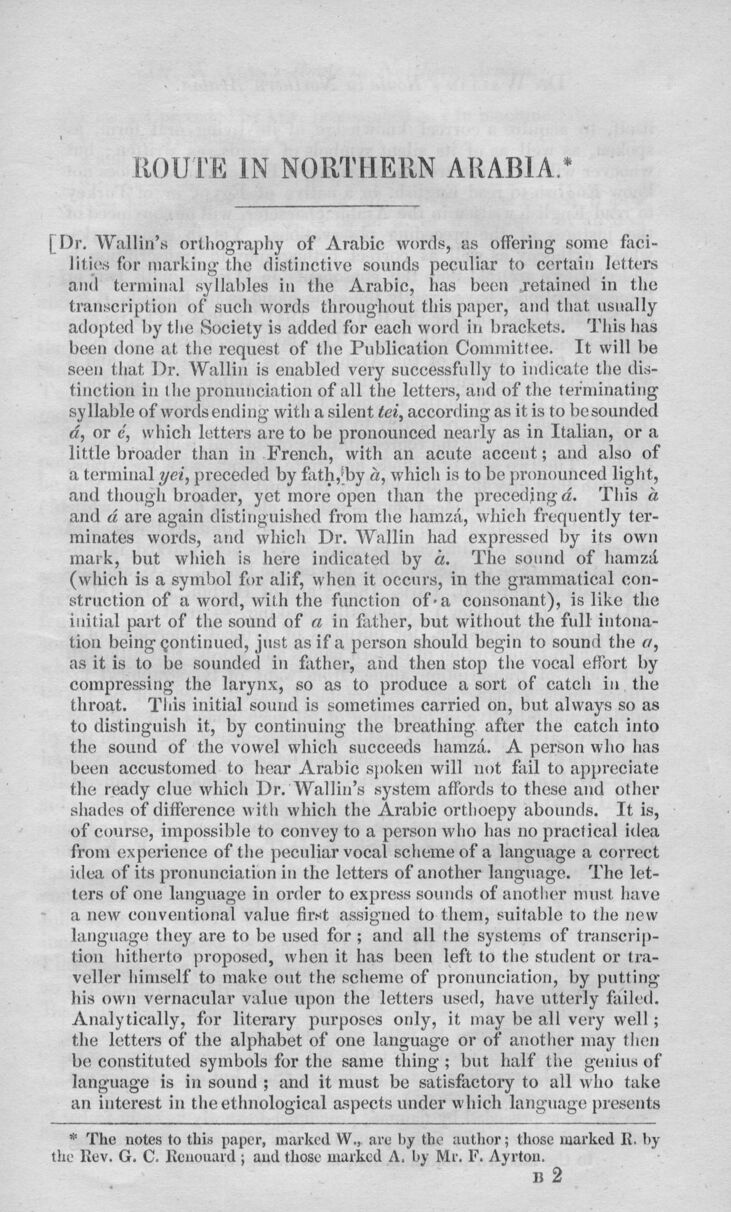
Full resolution (JPEG)
- On this page / på denna sida
- Route in Northern Arabia

<< prev. page << föreg. sida << >> nästa sida >> next page >>
Below is the raw OCR text
from the above scanned image.
Do you see an error? Proofread the page now!
Här nedan syns maskintolkade texten från faksimilbilden ovan.
Ser du något fel? Korrekturläs sidan nu!
This page has been proofread at least once.
(diff)
(history)
Denna sida har korrekturlästs minst en gång.
(skillnad)
(historik)
ROUTE IN NORTHERN ARABIA.
[1]
[Dr. Wallin’s orthography of Arabic words, as offering some
facilities for marking the distinctive sounds peculiar to certain letters
and terminal syllables in the Arabic, has been retained in the
transcription of such words throughout this paper, and that usually
adopted by the Society is added for each word in brackets. This has
been done at the request of the Publication Committee. It will be
seen that Dr. Wallin is enabled very successfully to indicate the
distinction in the pronunciation of all the letters, and of the terminating
syllable of words ending with a silent tei, according as it is to be sounded
á, or e, which letters are to be pronounced nearly as in Italian, or a
little broader than in French, with an acute accent; and also of
a terminal yei, preceded by fatḥ, by à, which is to be pronounced light,
and though broader, yet more open than the preceding á. This à
and á are again distinguished from the hamzá, which frequently
terminates words, and which Dr. Wallin had expressed by its own
mark, but which is here indicated by ȧ. The sound of hamzá
(which is a symbol for alif, when it occurs, in the grammatical
construction of a word, with the function of a consonant), is like the
initial part of the sound of a in father, but without the full
intonation being continued, just as if a person should begin to sound the a,
as it is to be sounded in father, and then stop the vocal effort by
compressing the larynx, so as to produce a sort of catch in the
throat. This initial sound is sometimes carried on, but always so as
to distinguish it, by continuing the breathing after the catch into
the sound of the vowel which succeeds hamzá. A person who has
been accustomed to hear Arabic spoken will not fail to appreciate
the ready clue which Dr. Wallin’s system affords to these and other
shades of difference with which the Arabic orthoepy abounds. It is,
of course, impossible to convey to a person who has no practical idea
from experience of the peculiar vocal scheme of a language a correct
idea of its pronunciation in the letters of another language. The
letters of one language in order to express sounds of another must have
a new conventional value first assigned to them, suitable to the new
language they are to be used for; and all the systems of
transcription hitherto proposed, when it has been left to the student or
traveller himself to make out the scheme of pronunciation, by putting
his own vernacular value upon the letters used, have utterly failed.
Analytically, for literary purposes only, it may be all very well;
the letters of the alphabet of one language or of another may then
be constituted symbols for the same thing; but half the genius of
language is in sound; and it must be satisfactory to all who take
an interest in the ethnological aspects under which language presents
[1] The notes to this paper, marked W., are by the author; those marked R. by
the Rev. G. C. Renouard; and those marked A. by Mr. F. Ayrton.
<< prev. page << föreg. sida << >> nästa sida >> next page >>
Project Runeberg, Tue Feb 6 00:54:23 2024
(aronsson)
(diff)
(history)
(download)
<< Previous
Next >>
https://runeberg.org/wganarabia/0007.html



